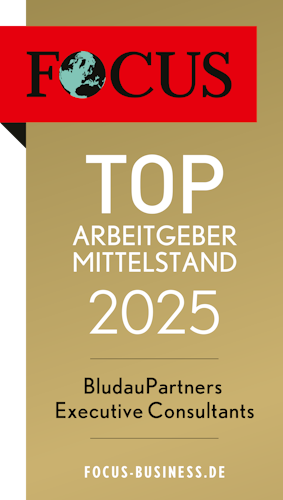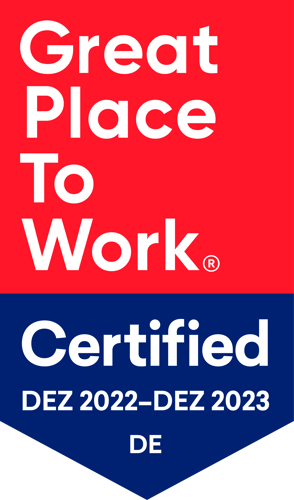WHAT WE HAVE TO DO TODAY TO STAY RELEVANT TOMORROW
"If it is certain that everything is uncertain, then the uncertainty is certain and therefore the leadership can in any case expect that it will turn out differently than planned, that it will take longer than promised and that the promises will not be kept as promised." [1]
"Organizational resilience is the ability of an organization to cushion and adapt in a changing environment in order to achieve, survive and thrive. More resilient organizations can anticipate and respond to risks and opportunities - due to sudden or gradual changes in the internal and external context". [2] ] Resilience is not a new concept, nor is the current corona crisis the first major challenge for organizations - but what it shows is once again the need for organizations to be robust.
HOW DOES THE CORONA CRISIS CHANGE LEADERSHIP CONCEPTS?
The strategic and organizational preparation for what might come seems unattainable in a world that is constantly changing. Which characteristics and structures of an organization can contribute to successful crisis management? A recent survey shows that "agile" companies are better able to get through uncertain and dynamic situations.[3] But what distinguishes such companies from those that fail because of these challenges?
In times of upheaval, the question of a solid foundation arises again and again. Companies struggling with disruption, crises and the resulting symptoms of organizational exhaustion often try to counteract the downfall by rapid leadership changes or authoritarian and rigid leadership, but in doing so they cause exactly the opposite. They rely too much on models that have been tried and tested over a long period of time, and are only conditionally prepared to give them up and embark on the unknown and insecure. It seems to be easier to put all resources on a tried and tested map, but it is all the more important to open up emerging issues and questions to all levels of the company. In the process of this reorientation and crisis management, various scenarios can arise that have a significant impact on future success or failure. The model of the Titanic Syndrome is an example of the dangers. [4]
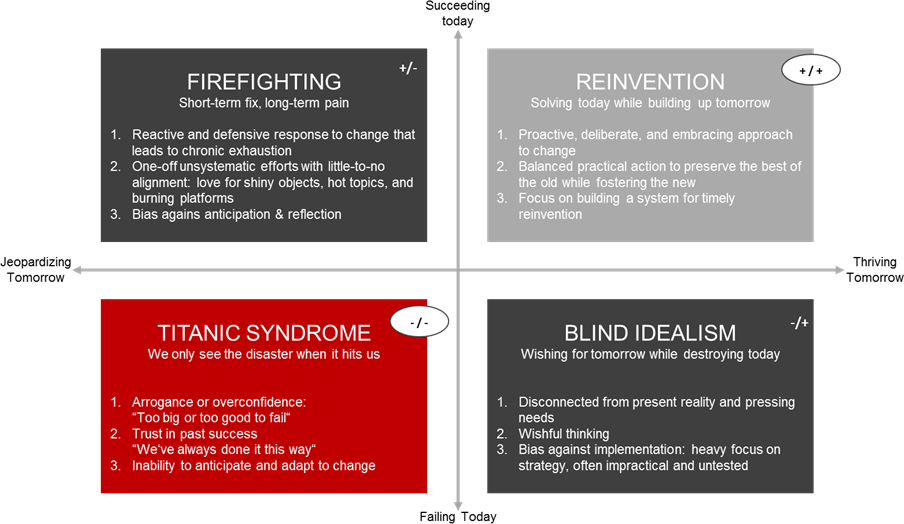
This model describes the situation that occurs when companies do not find suitable means to overcome the crisis. Warning signs are ignored for a long time, only noticed when the disaster occurs, so that the company is already in default of realigning itself strategically and organizationally in a new and resilient way. In order to carry out the structural realignment, it takes courage to allow new ideas to emerge, to venture into the unknown and to admit to oneself that the world is just the way it is. It will always happen that tragic circumstances or previously unknown states of crisis shake the familiar.
The Corona crisis is only exemplary, once again highlighting the urgency of repositioning organizations steadfastly and strategically. The balance of power shifts in favor of the employees, leadership becomes more agile and flexible, the question of meaning is not answered according to the top-down principle, instead all groups must be involved. The question of meaning can and must be discussed openly.
WHAT KIND OF EMPLOYEES ARE NEEDED TO MAKE THE COMPANY RESILIENT?
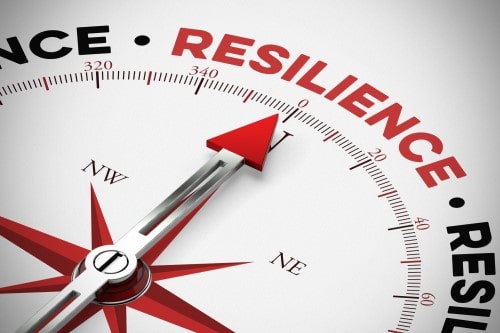
The Zukunftsinstitut presents six lifestyles of employees that can help to overcome such a crisis: The Forward Mover, the Golden Mentor, the Party Hopper, the Modern Nomad, the Digital Creative and the Sense Careerist. [1] What distinguishes them? Flexibility, self-realization, no fear of the unknown and curiosity. It is often those who in pre-Corona times did not like to commit themselves to companies in the long term, whose ideas were often rejected as absurd and unrealistic. They are the ones who quickly get bored in their conventional everyday work, who are bubbling over with new ideas or at least know how to implement them. But they are also those who, with a calm mind, critical awareness, reflection and skills from past crisis situations, know how to keep calm in a restless environment. Social bonding, health and self-realization are close to their hearts, they think and act holistically, are not thrown off course by the crisis. They are willing to rethink things, they know how to contribute to leading the company out of the crisis with prudence as well as with adaptation and responsibility.
HOW CAN EXECUTIVES BE A DRIVING FORCE FOR CHANGE?
“By the very nature of your position, you can help individuals and companies begin to heal by taking actions that demonstrate your own compassion, thereby unleashing a compassionate response throughout the whole organization“ [6]
Here it is important to admit to oneself as a manager that the crisis cannot be overcome with a top-down strategy. By involving the most diverse characters, as listed here as examples, optimal strategy approaches and ideas can be collectively implemented. It is not enough to develop short-term crisis management strategies that are always looking for analogies to the past. A long-term, strategic resilience must go beyond what has been known up to now, question which events, employees and concepts are needed to be among those who are on the side of those who have made it at the end of a crisis.
THE FIVE STEPS TO ORGANIZATIONAL RESILIENCE
- Be prepared to leave old strategies and organizational approaches behind and break new ground.
- Discover the strengths of your employees: Position your team broadly and do not rely only on previous structures; diverse input and open discussion can be profitable, especially in dynamic times.
- Prepare yourself for a dynamic but also uncertain future: The current crisis will not be the last of its kind. Be aware of signals of change and do not wait until the pressure to act becomes overwhelming.
- Take this step together with your employees: Listen to their ideas, answer central questions not only top-down, but search collectively for new possibilities and openly discuss the question of meaning.
- Don't put all your eggs in one basket: While "all in" may have led to the goal in earlier times, it now helps to establish a portfolio of approaches and ideas, on the one hand to minimize risk and on the other hand to shine with experience..

WHAT DOES THIS MEAN FOR FUTURE ACTIONS?
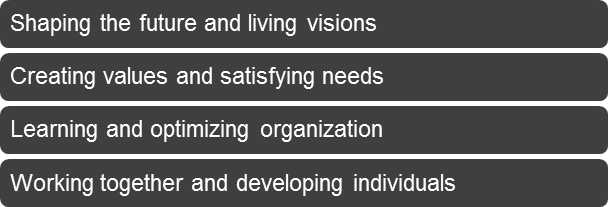
Development processes are necessary to make a company robust and crisis-resistant. These can be transferred into a superordinate model of organizational performance. Based on a common vision of the future within an organization, four core processes can be categorized: Shaping the future and living visions, creating values and satisfying needs, learning and optimizing the organization, working together and developing individuals. Each of these dimensions is assigned to further service areas. The first of the four core processes includes keywords such as strategy, leadership and purpose, while in the context of satisfying needs, the focus is on stakeholder interests and process optimization. Within organizational development, it is important to act innovatively and with foresight, to learn from the past and to collectively increase the resilience of the company through teamwork.
In times of upheaval, resilience is often underestimated, which once again underlines the importance of robustness and flexibility of organizational structures. Getting there does not require abrupt reorientation and repositioning, but rather insight and acceptance of the circumstances. In the next step, conclusions are drawn from this insight for one's own actions, the development and the future of the organization. In this step, consideration of the circumstances is just as important as communication with and involvement of the employees. Only together can stability be created and the company be set up for the future.
Author: Anna Feller
References:
[1] Greve, G. (2019). Organizational Burnout: Das versteckte Phänomen ausgebrannter Organisationen (4. Aufl.). Wiesbaden: Springer Gabler.
[2] juttaheller.de/resilienz/resilienz-abc/definition-organisationale-resilienz
[3] agile.iwi.unisg.ch/future-organization-report-2020
[4] Zhexembayeva, N. (2020). The Chief Reinvention Officer Handbook: How to Thrive in Chaos. Ideapress Publishing.
[5] zukunftsinstitut.de/fileadmin/user_upload/White_Paper_HR_Krisenresiliente_Lebensstile.pdf
[6] Lee, T. H., & Duckworth, A. L. (Hg.) (2020). HBR’s 10 Must Reads: On Organizational Resilience. Boston, Massachusetts: Harvard Business Review Press.








